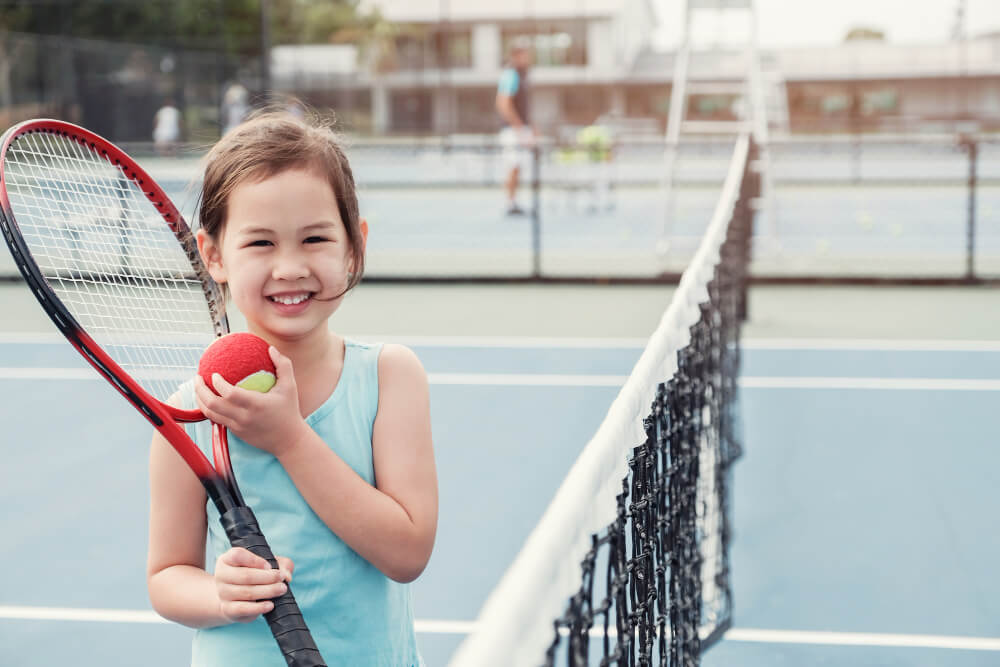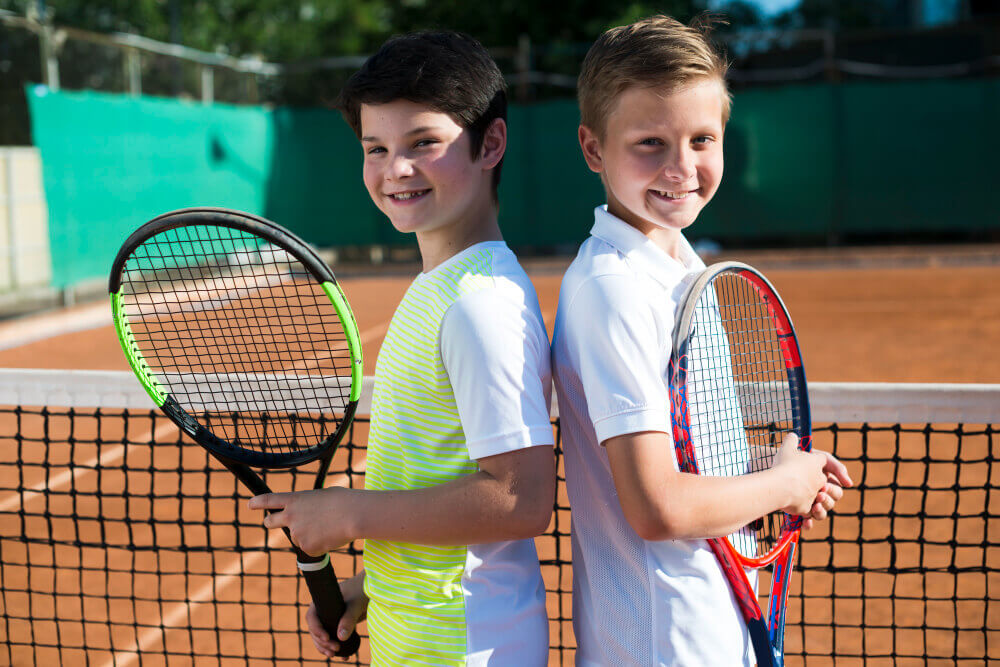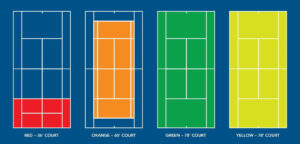Choosing the right junior tennis racquet is an essential step in helping your child develop their skills and enjoyment of the sport. With the right racquet, your child will be able to swing comfortably, generate power, and control their shots effectively.
On the other hand, a low-quality or larger racket will negatively impact their game and even cause injury.
With rackets costing from 20 bucks to 200, there is a plethora of options for you, as a parent. Let’s find out what goes into choosing the right junior racket and some personal experience from our family.
Table of Contents
Key factors to consider when choosing a junior tennis racquet:
Junior Racket Size
Quite possibly the most important factor when it comes to the best junior racket for your kid. The wrong size will negatively affect your kid’s performance and even do damage to their wrists.
As parents, we want our kids to achieve and impress. So it’s pretty normal for us to be proud to see our 5-year-old yield our adult-size racket and show off on the courts.
The problem is that a longer heavier racket is difficult to manage by a short person (your kiddo), they have less control on their shots and the added weight puts a strain on their wrists. No to mention that constantly smacking themselves with a huge racket isn’t fun either.
When we speak about racket size, we have 2 main things in mind: the racket length and weight:
Racket Length
If you need to see the proper tennis racket length for your kid, It’s best to have your child stand with the racquet in hand, feet flat on the ground, and arms extended straight down. The racquet should touch the ground — not rest on it.
If it doesn’t touch, try a longer size. Although it feels “cool” to have your kid play with a big racquet, a larger one will cause wrist issues in the future, especially for kids who play a lot of tennis.

Approximate Tennis Size and Age Guidelines:
- 2-4 years: 19 inches
- 4-8 years: 21-23 inches
- 8-10 years: 25 inches
- 11-13 years: 26 inches
- 14 years and up: 27 inches (adult size)
Growth spurts and strength may make adjustments necessary. In some cases, advanced tennis players will go over their regular racket size. We started with a very cheap 19 ” racket, when my daughter was 4 and a half, then transitioned to a 21″ and soon enough to 23″.
When moving up to 26″ as soon as she hit the Green Ball stage (read more about ROGY Tennis Development Pathway), my daughter struggled with the larger racket. It was a clear example of rushing into something she wasn’t ready for.
As a Green Ball player, she had to deal with playing full-court, with a higher-bounce ball and also a new, larger racket. On top of this, she played with the racket in a tournament for the first time and let’s say it was a big flop.
I realized we can actually still use her 25″ racket for some time and only after half a year passed she finally made the switch. She tried the new larger racket and immediately felt comfortable with it. It was clearly the time to move up a size.
The best way to gauge what your kid needs is to take the general guidelines as a starting point and then test out various options. If your kid is taller for their age, they can get a bigger racket. Also, high-performance junior players will move up faster with their racket sizes, as they have more control and need the added strength.
Testing Racquet Length for Your Child
Often, you’ll need to accurately measure the ideal racquet length for your child, ensuring a comfortable and effective tennis experience. This isn’t just about comfort – the right racquet length can significantly improve your child’s performance.
Here’s a simple FAQ guide to help you navigate this:
| Question | Answer |
|---|---|
| How do I measure? | Have your child stand straight, hold the racquet with the head touching the ground. The handle should reach their wrist. |
| What if it’s too long? | A long racquet can be heavy and hard to control. It’s best to go for a shorter one. |
| What if it’s too short? | A short racquet may limit reach and power. Opt for a slightly longer one. |
Junior Racket Weight
Lighter racquets (around 200 grams or less) are easier to maneuver and control, especially for younger or less experienced players. Heavier racquets can add power, but they can also be harder to swing and control.
Some parents rush into giving 26″ rackets to their 5 year olds, for instance, but, unless your child is tall and strong, you are just damaging their wrist.
A good way to see if the racket is too big is to watch your kid play. If you see the kid is constantly dropping the racket during play or having sloppy technique, get your kid to a smaller racket size and wait for a few more months or even a year before attempting an “upgrade”.
Junior Racket Head Size
A larger head size (over 100 square inches) is more forgiving and provides a larger sweet spot, making it easier to hit the ball consistently. Smaller head sizes offer more control and precision for advanced players.
Junior Racket Grip Size
A grip that’s too small can lead to hand fatigue and discomfort. A too-large grip can make it difficult to control the racquet. Measure your child’s hand or have them hold different grip sizes to find the right fit.
What Is the Best Size Tennis Racket for My Kid?
Choosing the best size tennis racket for your child involves considering their height, grip size, and comfort level. Rackets come in different sizes: 19′, 21′, 23′, 25′, and 26′. Typically, children under 4′ tall should use a 19′ racket, while those between 4′ and 4’6′ can opt for a 21′-23′ racket. If your child is between 4’6′ and 5′, a 25′ racket would be suitable, and over 5′, a 26′ racket is recommended.
Comfort is also vital. Your kid should be able to swing the racket comfortably without straining. Experimenting with different sizes can help identify what feels best.
Do I need to worry about grip size?
Yes, grip size is another crucial factor you’ll need to consider when choosing a tennis racket for your child.
- Comfort: A grip that’s too big or small can be uncomfortable and lead to poor performance.
- Injury Prevention: Incorrect grip sizes can increase the risk of wrist or elbow injuries.
- Skill Development: The right grip size allows your child to develop proper swinging and hitting techniques.
So, don’t overlook this aspect. It’s not just about the racket’s length or weight. The grip size can make a significant difference in your child’s tennis experience.
Junior Racket Flexibility
A more flexible racquet is easier to swing and generates more power, but may offer less control. A stiffer racquet provides more control and stability, but may be harder to swing for younger players.
Playing Style
For baseline players who want power and spin, consider racquets with a larger head size and a stiffer flex. For players who prefer volleying and touch shots, look for racquets with a smaller head size and a more flexible flex.
Skill Level
Beginner players should start with a lightweight racquet with a large head size. Consider racquets with smaller head sizes and stiffer flexes as skill level improves.
Junior Racket Brand
Several reputable brands offer junior tennis racquets, such as Babolat, Wilson, HEAD, Tecnifibre, and Yonex. In our case, Babolat junior tennis rackets have proven to be the best.
Junior Racket Price
Junior tennis racquets range in price from around $25 to $150. Consider your budget and the features that are important to your child.
When my daughter started playing tennis at 4, we bought the cheapest tennis racket. Now we don’t look at the price anymore, as, for a competitive junior tennis player, having a superior racket is a must.
Your Child’s Preferences
Involve your child in the decision-making process. Let them try out different racquets to see which one feels the most comfortable and enjoyable to play with.
FAQ
Can Adults Use Junior Racquets?
Although you might be tempted, as an adult, it’s not ideal to use a junior racket due to its smaller size and lighter weight. These rackets are designed specifically for children who are still growing and don’t provide the necessary power and control for an adult game. Using a junior racket can also lead to poor technique and even injury. You may find yourself overcompensating for the lack of weight and size, which can strain your muscles and joints.
What size tennis racket for a 12-year-old girl?
For a 12-year-old girl, you’d typically opt for a tennis racket that’s around 26 inches in length. This size is ideal considering her height, strength, and skill level. If the kid is more advanced and high for her age, she can transition to adult rackets, if comfortable as well.


